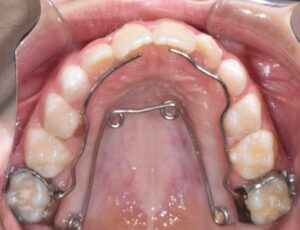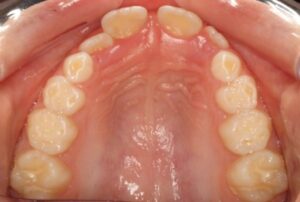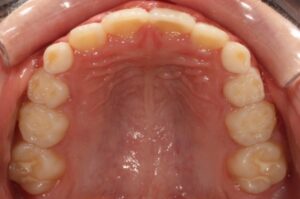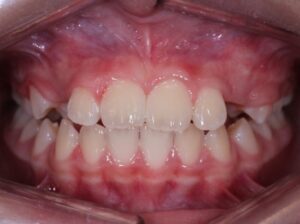Can my child benefit from an Orthodontic Expander?
January 9th, 2020
Can my child benefit from an Orthodontic Expander?
This is a common question concerned parents often ask. They also want to know if their child needs an expander then when is the best age to do it. In this blog we will cover these questions.
Upper Expander
When parents talk about expanders they are usually referring to upper jaw expanders (maxillary expansion). The lower jaw can also be expanded but that is a topic for another blog. We will focus on upper expanders here.
Let’s answer the age question first. The best time to do an upper expander is between the ages of 6 to 10 years old. The reason for this is the bones through the sutures are very malleable so are easily reshaped. The older a patient gets the harder the bones are to reshape and the less stable they are when you do.
Narrow “V” shaped upper jaw
There are two types of expansion
1. Dental
2.Skeletal
The best type of expansion in most instances is skeletal which is where the bones are reshaped because the results are more stable and the teeth are positioned more ideally over the bone which is healthier. So if you want the best expansion as mentioned earlier then do it in the 6-10 year old range. Dental expansion is where the bone stays the same shape and the back teeth are pushed out. This works best when the back teeth are angled inward.
Now, what are the benefits of using an Expander?
- More room for the permanent teeth and avoid extractions
- By developing more space, the permanent teeth can come in (erupt) into supporting bone which fosters healthy gums (less recession)
- Early skeletal expansion is more stable as noted earlier
- Promotes improved nasal breathing- being able to breathe through your nose is extremely important in proper facial development
- Decreases incidence of developing sleep apnea (OSA)
- Decreases “bed wetting” (enuresis)
- Possibly improves hearing in children with hearing loss
- Helps resolve tongue thrust which can create open bites of the front teeth and speech issues
- Can use to resolve thumb habits
- Can reshape narrow “V” shaped upper jaws into normal “U” shape which also can reduce protrusion of the front teeth
Pre expansion Post expansion
- Can also correct “underbites” if designed properly
Pre 3D expansion Post 3D expansion
- If performed properly can significantly reduce the time in braces as a teen
The key is to have a properly designed expander which can function in 3D. They have to be fixed (removable expanders, ones that can be taken in and out, do not predictably work!) They also should not have slots which need to be turned by you with a key. The slot is usually turned every other day which causes discomfort and is difficult to do.
Our office specifically designs each fixed expander to fit the needs of each child. Our patented 3D expander can work in all directions to achieve the most effective results. Other expanders only work in one direction. We activate the expander every 6 weeks so instead of potentially being uncomfortable every other day, the discomfort would be every 6-8 weeks for 3 to 4 visits. The 3D expander stays in for 6 months followed by 6 months of retention to ensure stability.
What are the downsides of expansion?
Really none, the predictability, the reduced need for extractions, the stability, less time in braces as a teen and better results! Plus as we mentioned it can help with sleep and optimum facial development.
If your child is in the 6-10 year old range, call us for a complimentary consultation.












